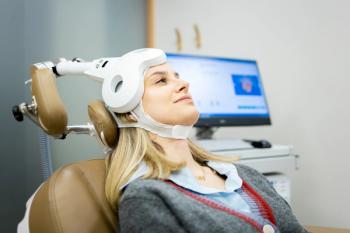
The Search for Postpartum Depression Biomarkers
Could the emerging field of epigenetics hold the key to catching postpartum depression before it happens?
The prevention of maternal psychiatric illness, particularly postpartum depression (PPD), has the potential to usher in far-reaching individual and societal consequences. A
In sum, targeting maternal mental health could improve both mental and physical outcomes for everyone in the home, and potentially improve outcomes for whole communities. While improving maternal mental health is bigger than preventing PPD, if we start with preventing PPD we can at least improve cognitive and mental health outcomes for both mothers and their children.
Risk Factors for Postpartum Depression
So how do we prevent PPD? One possibility is identifying markers or factors that are strongly predictive of PPD on an individual level, preferably prior to the onset of symptoms. These are collectively known as biomarkers: measurable substances whose presence is indicative or predictive of an illness’ onset and outcome.
PPD may be one of the easier psychiatric diseases to study, because you can identify the at-risk population and predict when the disease will occur. If you take 100 pregnant women, about 10 to 15 of them will become depressed in the first few weeks following childbirth. If those pregnant women have a history of a mood disorder and are not taking psychiatric medications the rate is
There are numerous factors associated with the development of PPD, at least on the group level. For example, having a psychiatric history prior to pregnancy, a family history of psychiatric illness including PPD, and being depressed in pregnancy are all associated with the
Perhaps our most promising biomarker potential for PPD is epigenetics. Marrying environmental influences and gene function,
The Search for Personalized Biomarkers
My colleagues and I have published a series of studies identifying 2 epigenetic biomarkers of PPD. In our first publication, we initially identified genetic loci that were responsive to high dose estrogen in the mouse hippocampus.7 We cross-referenced these loci to DNA methylation differences in samples of blood from pregnant women with mood disorders, who were followed prospectively through pregnancy and postpartum.
The initial sample included pregnant women who were clinically well during pregnancy and either did or did not develop PPD. Two loci were identified at the HP1BP3 and TTC9B genes which, based on methylation differences, were able to correctly identify whether a woman did or did not develop PPD with an
The exact functions of the TTC9B and HP1BP3 genes are currently unknown, but bioinformatics analysis suggests that both may be involved in mediating synaptic plasticity in the brain, and both have ties to estrogen signaling.7 Interestingly, mice without functioning HP1BP3 genes exhibit impaired maternal care, leading to a dramatic reduction in pup survival, indicating a role for the gene in maternal behavior.10 Further work on the functions of these 2 genes and their role in PPD may ultimately help elucidate the biological underpinnings of PPD.
Concluding Thoughts
What are the next steps? We are validating the biomarkers in a larger sample and examining what factors might be involved when there is a mismatch between what biomarkers predict and what actually happens from a psychiatric perspective postpartum.
The next important scientific step is to attempt the holy grail of psychiatry: a prevention study. Can PPD be prevented when a woman has the biomarkers in pregnancy or does having the biomarkers make the development of PPD inevitable? If PPD can be prevented, are there some interventions that are more effective than others?
Dr Payne is currently Associate Professor of Psychiatry and Director of the Johns Hopkins Women’s Mood Disorders Center at the Johns Hopkins School of Medicine, Baltimore, MD. Beginning September 1, She will become Professor of Psychiatry and Vice Chair of Research at the University of Virginia, Charlottesville, VA.
References
1. Grace SL, Evindar A, Stewart DE. The effect of postpartum depression on child cognitive development and behavior: a review and critical analysis of the literature. Arch Womens Ment Health. 2003;6(4):263-274.
2. Felitti VJ, Anda RF, Nordenberg D, et al. Relationship of childhood abuse and household dysfunction to many of the leading causes of death in adults. The Adverse Childhood Experiences (ACE) Study. Am J Prev Med. 1998;14(4):245-258.
3. Payne JL, Roy PS, Murphy-Eberenz K, et al. Reproductive cycle-associated mood symptoms in women with major depression and bipolar disorder. J Affect Disord. 2007;99(1-3):221-229.
4. Viguera AC, Tondo L, Koukopoulos AE, et al. Episodes of mood disorders in 2,252 pregnancies and postpartum periods. Am J Psychiatry. 2011;168(11):1179-1185.
5. Kimmel M, Hess E, Roy PS, et al. Family history, not lack of medication use, is associated with the development of postpartum depression in a high-risk sample. Arch Womens Ment Health. 2015;18(1):113-121.
6. Guintivano J, Manuck T, Meltzer-Brody S. Predictors of postpartum depression: a comprehensive review of the last decade of evidence. Clin Obstet Gynecol. 2018;61(3):591-603.
7. Guintivano J, Arad M, Gould TD, et al. Antenatal prediction of postpartum depression with blood DNA methylation biomarkers. Mol Psychiatry. 2014;19(5):560-567.
8. Osborne L, Clive M, Kimmel M, et al. Replication of epigenetic postpartum depression biomarkers and variation with hormone levels. Neuropsychopharmacology. 2016;41(6):1648-1658.
9. Payne JL, Osborne LM, Cox O, et al. DNA methylation biomarkers prospectively predict both antenatal and postpartum depression. Psychiatry Res. 2020;285:112711.
10. Garfinkel BP, Arad S, Neuner SM, et al. HP1BP3 expression determines maternal behavior and offspring survival. Genes Brain Behav. 2016;15(7):678-688.
Newsletter
Receive trusted psychiatric news, expert analysis, and clinical insights — subscribe today to support your practice and your patients.













